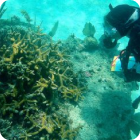
By: Kyle Grammatica
One important project is working to restore lost clam populations from the Indian River Lagoon. Blair Wiggins of Addictive Fishing Television, the Coastal Conservation Association, the Florida Fish and Wildlife Conservation Commission (FWC), and UF’s Whitney Laboratory for Marine Bioscience are planting 3.4 million clams throughout lagoon this year.
Clams in the Indian River Lagoon were once plentiful, but in recent years they’ve mostly vanished. The project organizers searched the lagoon for remaining clams until finally one population was discovered in southern Mosquito Lagoon. 39 tough-as-nails clams were harvested to create a new generation of millions of hardy clams throughout the lagoon. The baby clams are currently being planted under the cover of netting to protect them from predators. Once the planting is completed, the clams will be monitored while they hopefully thrive.
Loss of Clams in the Indian River Lagoon
We’re not completely sure what led to the loss of clams in the Indian River Lagoon. Clamming was once popular in the region, but around 30 years ago, the practice largely ceased as the businesses could no longer make a profit. Overharvesting could have played a role in the loss, but other factors like pollution, extreme weather, and water quality changes could also be culprits.
Importance of Clams
Clams play an important role in the ecosystem. They can filter up to 25 gallons of water a day, removing harmful algae, nitrogen, and phosphorous. This keeps the water clean and clear, allowing plants and animals to thrive. Without clams, the entire Indian River Lagoon suffers. This is why we work to protect all of Florida’s wildlife, no matter how small. To support our efforts, donate here.












